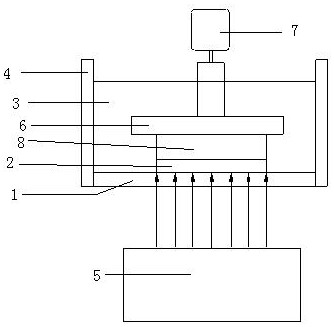A fast 3D printing system
A 3D printing and fast technology, applied in the direction of 3D object support structure, manufacturing tools, additive manufacturing, etc., can solve the problems of low printing accuracy, uncontrollable deformation amount and deformation shape, easy wear and tear, etc., and achieve a controllable printing process Effect
- Summary
- Abstract
- Description
- Claims
- Application Information
AI Technical Summary
Problems solved by technology
Method used
Image
Examples
Embodiment 1
[0029] like figure 1 As shown, the rapid 3D printing system of this embodiment includes a titanium dioxide window (1), an uncured layer (2), a photosensitive resin (3), a trough (4), an optical device (5), and an object stage (6) , motor (7) and cured product (8), described titanium dioxide window (1) is positioned at the bottom of trough (4); Described photosensitive resin (3) is located at the inside of trough (4);
[0030] The formation process of the uncured layer (2) is as follows: the optical device (5) projects light onto the titanium dioxide window (1) under the control of the program, and the titanium dioxide window (1) absorbs part of the light to generate oxygen-containing free radicals and the photosensitive resin (3) React to form an uncured layer (2) between it and the cured product (8), while the photosensitive resin farther away from the titanium dioxide window (1) is cured by light to form a cured product (8), and the final performance is: The photosensitive ...
Embodiment 2
[0036] like figure 1 As shown, the rapid 3D printing system of this embodiment includes a titanium dioxide window (1), an uncured layer (2), a photosensitive resin (3), a trough (4), an optical device (5), and an object stage (6) , motor (7) and cured product (8), described titanium dioxide window (1) is positioned at the bottom of trough (4); Described photosensitive resin (3) is located at the inside of trough (4);
[0037]The formation process of the uncured layer (2) is as follows: the optical device (5) projects light onto the titanium dioxide window (1) under the control of the program, and the titanium dioxide window (1) absorbs part of the light to generate oxygen-containing free radicals and the photosensitive resin (3) React to form an uncured layer (2) between it and the cured product (8), while the photosensitive resin farther away from the titanium dioxide window (1) is cured by light to form a cured product (8), and the final performance is: The photosensitive r...
Embodiment 3
[0044] like figure 1 As shown, the rapid 3D printing system of this embodiment includes a titanium dioxide window (1), an uncured layer (2), a photosensitive resin (3), a trough (4), an optical device (5), and an object stage (6) , motor (7) and cured product (8), described titanium dioxide window (1) is positioned at the bottom of trough (4); Described photosensitive resin (3) is located at the inside of trough (4);
[0045] The formation process of the uncured layer (2) is as follows: the optical device (5) projects light onto the titanium dioxide window (1) under the control of the program, and the titanium dioxide window (1) absorbs part of the light to generate oxygen-containing free radicals and the photosensitive resin (3) React to form an uncured layer (2) between it and the cured product (8), while the photosensitive resin farther away from the titanium dioxide window (1) is cured by light to form a cured product (8), and the final performance is: The photosensitive ...
PUM
| Property | Measurement | Unit |
|---|---|---|
| thickness | aaaaa | aaaaa |
| wavelength | aaaaa | aaaaa |
| thickness | aaaaa | aaaaa |
Abstract
Description
Claims
Application Information
 Login to View More
Login to View More - R&D
- Intellectual Property
- Life Sciences
- Materials
- Tech Scout
- Unparalleled Data Quality
- Higher Quality Content
- 60% Fewer Hallucinations
Browse by: Latest US Patents, China's latest patents, Technical Efficacy Thesaurus, Application Domain, Technology Topic, Popular Technical Reports.
© 2025 PatSnap. All rights reserved.Legal|Privacy policy|Modern Slavery Act Transparency Statement|Sitemap|About US| Contact US: help@patsnap.com

